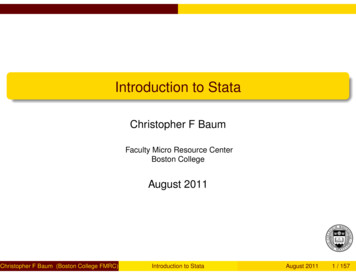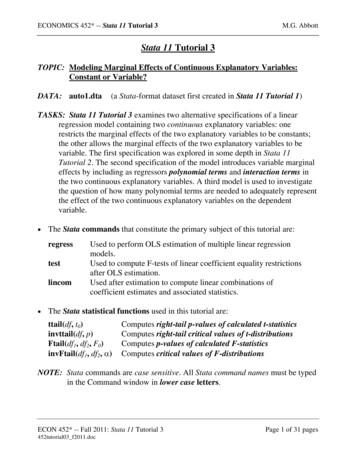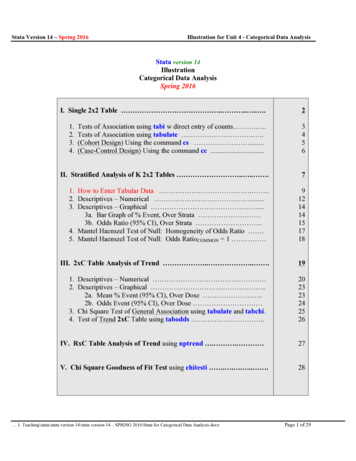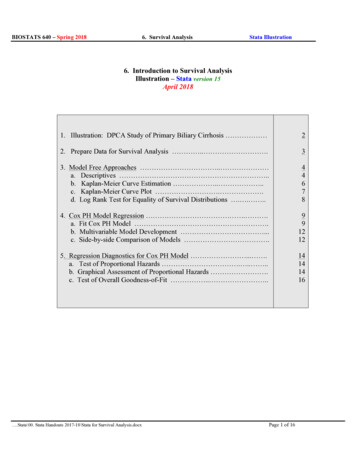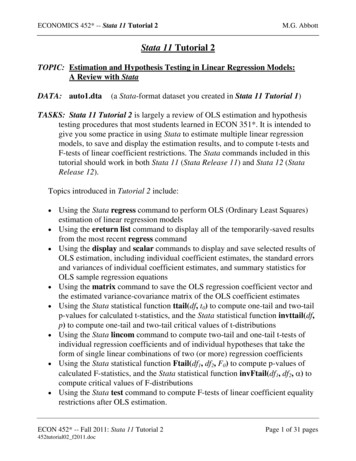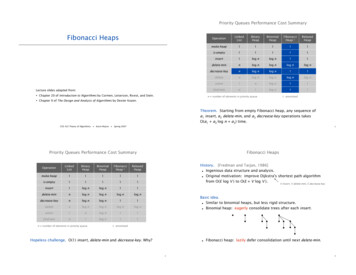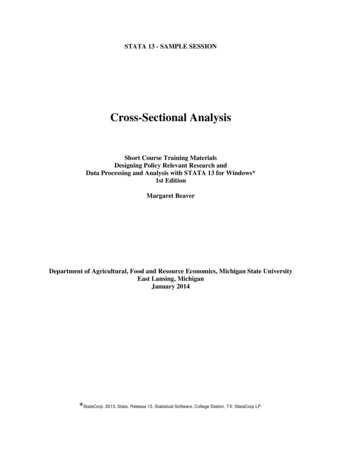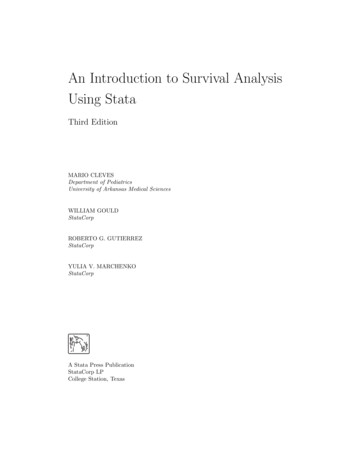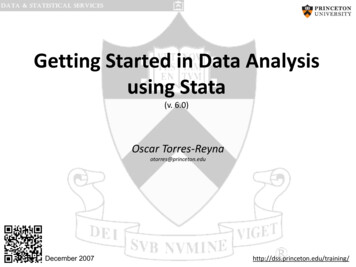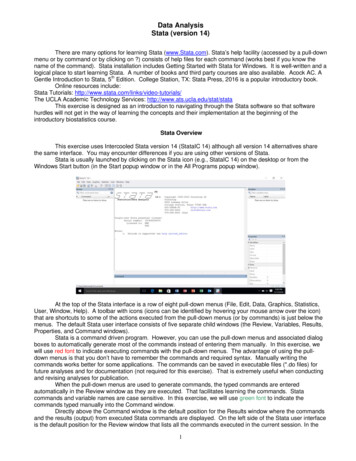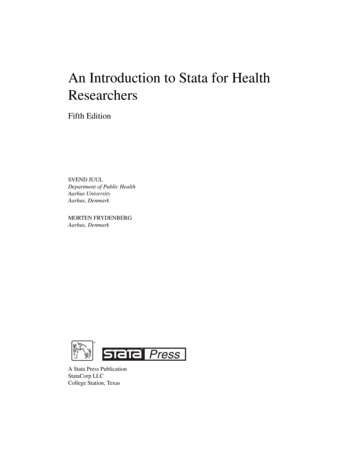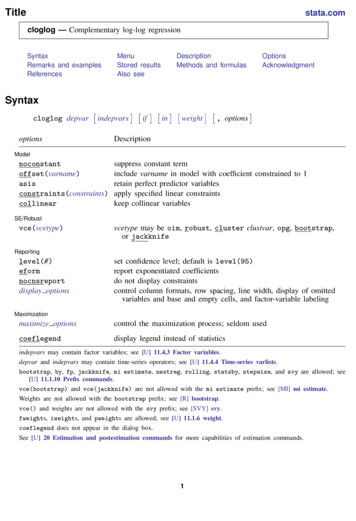
Transcription
Titlestata.comcloglog — Complementary log-log regressionSyntaxRemarks and examplesReferencesMenuStored resultsAlso seeDescriptionMethods and formulasOptionsAcknowledgmentSyntaxcloglog depvar indepvarsoptions if in weight , options raints(constraints)collinearsuppress constant terminclude varname in model with coefficient constrained to 1retain perfect predictor variablesapply specified linear constraintskeep collinear variablesSE/Robustvce(vcetype)vcetype may be oim, robust, cluster clustvar, opg, bootstrap,or jackknifeReportinglevel(#)eformnocnsreportdisplay optionsset confidence level; default is level(95)report exponentiated coefficientsdo not display constraintscontrol column formats, row spacing, line width, display of omittedvariables and base and empty cells, and factor-variable labelingMaximizationmaximize optionscontrol the maximization process; seldom usedcoeflegenddisplay legend instead of statisticsindepvars may contain factor variables; see [U] 11.4.3 Factor variables.depvar and indepvars may contain time-series operators; see [U] 11.4.4 Time-series varlists.bootstrap, by, fp, jackknife, mi estimate, nestreg, rolling, statsby, stepwise, and svy are allowed; see[U] 11.1.10 Prefix commands.vce(bootstrap) and vce(jackknife) are not allowed with the mi estimate prefix; see [MI] mi estimate.Weights are not allowed with the bootstrap prefix; see [R] bootstrap.vce() and weights are not allowed with the svy prefix; see [SVY] svy.fweights, iweights, and pweights are allowed; see [U] 11.1.6 weight.coeflegend does not appear in the dialog box.See [U] 20 Estimation and postestimation commands for more capabilities of estimation commands.1
2cloglog — Complementary log-log regressionMenuStatistics Binary outcomes Complementary log-log regressionDescriptioncloglog fits maximum-likelihood complementary log-log models.See [R] logistic for a list of related estimation commands.Options Modelnoconstant, offset(varname); see [R] estimation options.asis forces retention of perfect predictor variables and their associated perfectly predicted observationsand may produce instabilities in maximization; see [R] probit.constraints(constraints), collinear; see [R] estimation options. SE/Robustvce(vcetype) specifies the type of standard error reported, which includes types that are derived fromasymptotic theory (oim, opg), that are robust to some kinds of misspecification (robust), thatallow for intragroup correlation (cluster clustvar), and that use bootstrap or jackknife methods(bootstrap, jackknife); see [R] vce option. Reportinglevel(#); see [R] estimation options.eform displays the exponentiated coefficients and corresponding standard errors and confidenceintervals.nocnsreport; see [R] estimation options.display options: noomitted, vsquish, noemptycells, baselevels, allbaselevels, nofvlabel, fvwrap(#), fvwrapon(style), cformat(% fmt), pformat(% fmt), sformat(% fmt), andnolstretch; see [R] estimation options. Maximization maximize options: difficult, technique(algorithm spec), iterate(#), no log, trace,gradient, showstep, hessian, showtolerance, tolerance(#), ltolerance(#),nrtolerance(#), nonrtolerance, and from(init specs); see [R] maximize. These options areseldom used.Setting the optimization type to technique(bhhh) resets the default vcetype to vce(opg).The following option is available with cloglog but is not shown in the dialog box:coeflegend; see [R] estimation options.
cloglog — Complementary log-log regressionRemarks and examples3stata.comRemarks are presented under the following headings:Introduction to complementary log-log regressionRobust standard errorsIntroduction to complementary log-log regressioncloglog fits maximum likelihood models with dichotomous dependent variables coded as 0/1 (or,more precisely, coded as 0 and not 0).Example 1We have data on the make, weight, and mileage rating of 22 foreign and 52 domestic automobiles.We wish to fit a model explaining whether a car is foreign based on its weight and mileage. Here isan overview of our data:. use http://www.stata-press.com/data/r13/auto(1978 Automobile Data). keep make mpg weight foreign. describeContains data from 1978 Automobile Datavars:413 Apr 2013 17:45size:1,702( dta has notes)variable r18intintbyteSorted by:Note:%-18s%8.0g%8.0gc%8.0gvaluelabelvariable labeloriginMake and ModelMileage (mpg)Weight (lbs.)Car typeforeigndataset has changed since last saved. inspect foreignforeign:######Car typeNumber of tal522274-Integers5222Nonintegers-74-74(2 unique values)foreign is labeled and all values are documented in the label.The variable foreign takes on two unique values, 0 and 1. The value 0 denotes a domestic car,and 1 denotes a foreign car.
4cloglog — Complementary log-log regressionThe model that we wish to fit isPr(foreign 1) F (β0 β1 weight β2 mpg)where F (z) 1 exp exp(z) .To fit this model, we type. cloglog foreign weight mpgIteration 0:log likelihood -34.054593Iteration 1:log likelihood -27.869915Iteration 2:log likelihood -27.742997Iteration 3:log likelihood -27.742769Iteration 4:log likelihood -27.742769Complementary log-log regressionNumber of obsZero outcomesNonzero outcomesLR chi2(2)Prob chi2Log likelihood 91110.09694Std. Err.0006974.0763873.351841z-4.18-1.863.01P z 0.0000.0620.003 74522234.580.0000[95% Conf. 4716.66642We find that heavier cars are less likely to be foreign and that cars yielding better gas mileage arealso less likely to be foreign, at least when holding the weight of the car constant.See [R] maximize for an explanation of the output.Technical noteStata interprets a value of 0 as a negative outcome (failure) and treats all other values (exceptmissing) as positive outcomes (successes). Thus, if your dependent variable takes on the values 0 and1, 0 is interpreted as failure and 1 as success. If your dependent variable takes on the values 0, 1,and 2, 0 is still interpreted as failure, but both 1 and 2 are treated as successes.If you prefer a more formal mathematical statement, when you type cloglog y x, Stata fits themodelnoPr(yj 6 0 xj ) 1 exp exp(xj β)Robust standard errorsIf you specify the vce(robust) option, cloglog reports robust standard errors, as described in[U] 20.21 Obtaining robust variance estimates. For the model of foreign on weight and mpg, therobust calculation increases the standard error of the coefficient on mpg by 44%:
cloglog — Complementary log-log regression5. cloglog foreign weight mpg, olikelihood Complementary log-log regressionLog pseudolikelihood 91110.09694RobustStd. Err.0007484.11024664.317305z-3.90-1.292.34Number of obsZero outcomesNonzero outcomes 745222Wald chi2(2)Prob chi2 29.740.0000P z 0.0000.1970.019[95% Conf. 8218.5587Without vce(robust), the standard error for the coefficient on mpg was reported to be 0.076, witha resulting confidence interval of [ 0.29, 0.01 ].The vce(cluster clustvar) option can relax the independence assumption required by thecomplementary log-log estimator to being just independence between clusters. To demonstrate thisability, we will switch to a different dataset.We are studying unionization of women in the United States by using the union dataset; see[XT] xt. We fit the following model, ignoring that women are observed an average of 5.9 times eachin this dataset:. use http://www.stata-press.com/data/r13/union, clear(NLS Women 14-24 in 1968). cloglog union age grade not smsa ikelihood ary log-log regressionLog likelihood -13540.607Std. Err.zNumber of obsZero outcomesNonzero outcomes 26200203895811LR chi2(6)Prob chi2 647.240.0000unionCoef.P z [95% Conf. Interval]agegradenot 52374-4.130.000-1.798455-.6411462
6cloglog — Complementary log-log regressionThe reported standard errors in this model are probably meaningless. Women are observed repeatedly,and so the observations are not independent. Looking at the coefficients, we find a large southerneffect against unionization and a different time trend for the south. The vce(cluster clustvar)option provides a way to fit this model and obtains correct standard errors:. cloglog union age grade not smsa south##c.year, vce(cluster id) nologComplementary log-log regressionLog pseudolikelihood -13540.607Number of obsZero outcomesNonzero outcomes 26200203895811Wald chi2(6)Prob chi2 160.760.0000(Std. Err. adjusted for 4434 clusters in idcode)RobustStd. Err.unionCoef.zP z [95% Conf. Interval]agegradenot 129-2.360.018-2.234107-.2054942These standard errors are larger than those reported by the inappropriate conventional calculation.By comparison, another way we could fit this model is with an equal-correlation population-averagedcomplementary log-log model:. xtcloglog union age grade not smsa south##c.year, pa nologGEE population-averaged modelGroup ion:exchangeableScale parameter:Number of obsNumber of groupsObs per group: minavgmaxWald chi2(6)Prob chi21Std. Err.zP z 26200443415.912234.660.0000unionCoef.[95% Conf. Interval]agegradenot 68005-3.330.001-2.363991-.6125652The coefficient estimates are similar, but these standard errors are smaller than those produced bycloglog, vce(cluster clustvar). This finding is as we would expect. If the within-panel correlationassumptions are valid, the population-averaged estimator should be more efficient.
cloglog — Complementary log-log regression7In addition to this estimator, we may use the xtgee command to fit a panel estimator (withcomplementary log-log link) and any number of assumptions on the within-idcode correlation.cloglog, vce(cluster clustvar) is robust to assumptions about within-cluster correlation. Thatis, it inefficiently sums within cluster for the standard-error calculation rather than attempting to exploitwhat might be assumed about the within-cluster correlation (as do the xtgee population-averagedmodels).Stored resultscloglog stores the following in e():Scalarse(N)e(k)e(k eq)e(k eq model)e(k dv)e(N f)e(N s)e(df m)e(ll)e(ll 0)e(N pt)e(which)e(ml e(gradient)e(V)e(V modelbased)Functionse(sample)number of observationsnumber of parametersnumber of equations in e(b)number of equations in overall model testnumber of dependent variablesnumber of zero outcomesnumber of nonzero outcomesmodel degrees of freedomlog likelihoodlog likelihood, constant-only modelnumber of clustersχ2significancerank of e(V)number of iterationsreturn code1 if converged, 0 otherwisecloglogcommand as typedname of dependent variableweight typeweight expressiontitle in estimation outputname of cluster variablelinear offset variableWald or LR; type of model χ2 testvcetype specified in vce()title used to label Std. Err.type of optimizationmax or min; whether optimizer is to perform maximization or minimizationtype of ml methodname of likelihood-evaluator programmaximization techniqueb Vprogram used to implement predictfactor variables fvset as asbalancedfactor variables fvset as asobservedcoefficient vectorconstraints matrixiteration log (up to 20 iterations)gradient vectorvariance–covariance matrix of the estimatorsmodel-based variancemarks estimation sample
8cloglog — Complementary log-log regressionMethods and formulasComplementary log-log analysis (related to the gompit model, so named because of its relationshipto the Gompertz distribution) is an alternative to logit and probit analysis, but it is unlike these otherestimators in that the transformation is not symmetric. Typically, this model is used when the positive(or negative) outcome is rare.The log-likelihood function for complementary log-log islnL Xj Swj lnF (xj b) Xnowj ln 1 F (xj b)j6 S where S is the set of all observations j such that yj 6 0, F (z) 1 exp exp(z) , and wjdenotes the optional weights. lnL is maximized as described in [R] maximize.We can fit a gompit model by reversing the success–failure sense of the dependent variable andusing cloglog.This command supports the Huber/White/sandwich estimator of the variance and its clusteredversion using vce(robust) and vce(cluster clustvar), respectively. See [P] robust, particularlyMaximum likelihoodestimators and Methods and formulas. The scores are calculated as uj [exp(xj b) exp exp(xj b) /F (xj b)]xj for the positive outcomes and { exp(xj b)}xj for thenegative outcomes.cloglog also supports estimation with survey data. For details on VCEs with survey data, see[SVY] variance estimation.AcknowledgmentWe thank Joseph Hilbe of Arizona State University for providing the inspiration for the cloglogcommand (Hilbe 1996, 1998).ReferencesClayton, D. G., and M. Hills. 1993. Statistical Models in Epidemiology. Oxford: Oxford University Press.Hilbe, J. M. 1996. sg53: Maximum-likelihood complementary log-log regression. Stata Technical Bulletin 32: 19–20.Reprinted in Stata Technical Bulletin Reprints, vol. 6, pp. 129–131. College Station, TX: Stata Press. 1998. sg53.2: Stata-like commands for complementary log-log regression. Stata Technical Bulletin 41: 23.Reprinted in Stata Technical Bulletin Reprints, vol. 7, pp. 166–167. College Station, TX: Stata Press.Long, J. S. 1997. Regression Models for Categorical and Limited Dependent Variables. Thousand Oaks, CA: Sage.Long, J. S., and J. Freese. 2014. Regression Models for Categorical Dependent Variables Using Stata. 3rd ed. CollegeStation, TX: Stata Press.Xu, J., and J. S. Long. 2005. Confidence intervals for predicted outcomes in regression models for categoricaloutcomes. Stata Journal 5: 537–559.
cloglog — Complementary log-log regressionAlso see[R] cloglog postestimation — Postestimation tools for cloglog[R] clogit — Conditional (fixed-effects) logistic regression[R] glm — Generalized linear models[R] logistic — Logistic regression, reporting odds ratios[R] scobit — Skewed logistic regression[ME] mecloglog — Multilevel mixed-effects complementary log-log regression[MI] estimation — Estimation commands for use with mi estimate[SVY] svy estimation — Estimation commands for survey data[XT] xtcloglog — Random-effects and population-averaged cloglog models[U] 20 Estimation and postestimation commands9
cloglog— Complementary log-log regression 3 Remarks and examples stata.com Remarks are presented under the following headings: Introduction to complementary log-log regression Robust standard errors Introduction to complementary log-log regression cloglog fits maximum likelihood models with dichotomous dependent variables coded as 0/1 (or,
